-

新人教版高中英语选修2Unit 4 Learning about Language教学设计
This section guides students to pay attention to the typical context of vocabulary use, helps students accumulate vocabulary around the key vocabulary of this unit, and uses the learned words and word chunks in different contexts to deeply understand their meaning and usage, so as to achieve the purpose of review and consolidation.The teaching design activities aim to guide students to pay attention to the typical context in which the target vocabulary is used, as well as the common vocabulary used in collocation, so that students can complete the sentence with correct words. In terms of vocabulary learning strategies, this unit focuses on cultivating students' ability to pay attention to collocation of words and to use word blocks to express meaning.For vocabulary learning, it is not enough just to know the meaning of a single word, but the most important thing is to master the common collocations of words, namely word blocks.Teachers should timely guide students to summarize common vocabulary collocation, such as verb and noun collocation, verb and preposition collocation, preposition and noun collocation, and so on.1. Guide students to understand and consolidate the meaning and usage of the vocabulary in the context, 2. Guide the students to use the unit topic vocabulary in a richer context3. Let the students sort out and accumulate the accumulated vocabulary, establishes the semantic connection between the vocabulary,4. Enable students to understand and master the vocabulary more effectivelyGuiding the Ss to use unit topic words and the sentence patterns in a richer context.

新人教版高中英语选修2Unit 5 Learning about Language教学设计
The purpose of this section of vocabulary exercises is to consolidate the key words in the first part of the reading text, let the students write the words according to the English definition, and focus on the detection of the meaning and spelling of the new words. The teaching design includes use English definition to explain words, which is conducive to improving students' interest in vocabulary learning, cultivating their sense of English language and thinking in English, and making students willing to use this method to better grasp the meaning of words, expand their vocabulary, and improve their ability of vocabulary application. Besides, the design offers more context including sentences and short passage for students to practice words flexibly.1. Guide students to understand and consolidate the meaning and usage of the vocabulary in the context, 2. Guide the students to use the unit topic vocabulary in a richer context3. Let the students sort out and accumulate the accumulated vocabulary, establishes the semantic connection between the vocabulary,4. Enable students to understand and master the vocabulary more effectivelyGuiding the Ss to use unit topic words and the sentence patterns in a richer context.Step1: Read the passage about chemical burns and fill in the blanks with the correct forms of the words in the box.

新人教版高中英语选修2Unit 5 Reading and thinking教学设计
The theme of this activity is to learn the first aid knowledge of burns. Burns is common in life, but there are some misunderstandings in manual treatment. This activity provides students with correct first aid methods, so as not to take them for granted in an emergency. This section guides students to analyze the causes of scald and help students avoid such things. From the perspective of text structure and collaborative features, the text is expository. Expository, with explanation as the main way of expression, transmits knowledge and information to readers by analyzing concepts and elaborating examples. This text arranges the information in logical order, clearly presents three parts of the content through the subtitle, accurately describes the causes, types, characteristics and first aid measures of burns, and some paragraphs use topic sentences to summarize the main idea, and the level is very clear.1. Guide students to understand the causes, types, characteristics and first aid methods of burns, through reading2. Enhance students’ ability to deal withburnss and their awareness of burns prevention3. Enable students to improve the ability to judge the types of texts accurately and to master the characteristics and writing techniques of expository texts.Guide students to understand the causes, types, characteristics and first aid methods of burns, through readingStep1: Lead in by discussing the related topic:1. What first-aid techniques do you know of ?CPR; mouth to mouth artificial respiration; the Heimlich Manoeuvre

新人教版高中英语选修2Unit 5 Using langauge-Listening教学设计
The theme of this section is to learn how to make emergency calls. Students should learn how to make emergency calls not only in China, but also in foreign countries in English, so that they can be prepared for future situations outside the home.The emergency telephone number is a vital hotline, which should be the most clear, rapid and effective communication with the acute operator.This section helps students to understand the emergency calls in some countries and the precautions for making emergency calls. Through the study of this section, students can accumulate common expressions and sentence patterns in this context. 1.Help students accumulate emergency telephone numbers in different countries and learn more about first aid2.Guide the students to understand the contents and instructions of the telephone, grasp the characteristics of the emergency telephone and the requirements of the emergency telephone.3.Guide students to understand the first aid instructions of the operators.4.Enable Ss to make simulated emergency calls with their partners in the language they have learned1. Instruct students to grasp the key information and important details of the dialogue.2. Instruct students to conduct a similar talk on the relevant topic.Step1:Look and discuss:Match the pictures below to the medical emergencies, and then discuss the questions in groups.
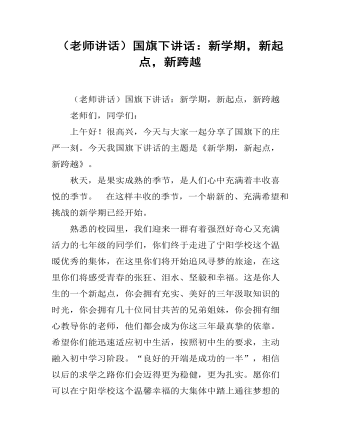
(老师讲话)国旗下讲话:新学期,新起点,新跨越
秋天,是果实成熟的季节,是人们心中充满着丰收喜悦的季节。 在这样丰收的季节,一个崭新的、充满希望和挑战的新学期已经开始。熟悉的校园里,我们迎来一群有着强烈好奇心又充满活力的七年级的同学们,你们终于走进了宁阳学校这个温暖优秀的集体,在这里你们将开始追风寻梦的旅途,在这里你们将感受青春的张狂、泪水、坚毅和幸福。这是你人生的一个新起点,你会拥有充实、美好的三年汲取知识的时光,你会拥有几十位同甘共苦的兄弟姐妹,你会拥有细心教导你的老师,他们都会成为你这三年最真挚的依靠。希望你们能迅速适应初中生活,按照初中生的要求,主动融入初中学习阶段。“良好的开端是成功的一半”,相信以后的求学之路你们会迈得更为稳健,更为扎实。愿你们可以在宁阳学校这个温馨幸福的大集体中踏上通往梦想的旅途,愿你们可以在这里拥有美好而又难忘的三年初中生活,愿你们可以用自己的辛勤与汗水去创造更加美好灿烂的明天!
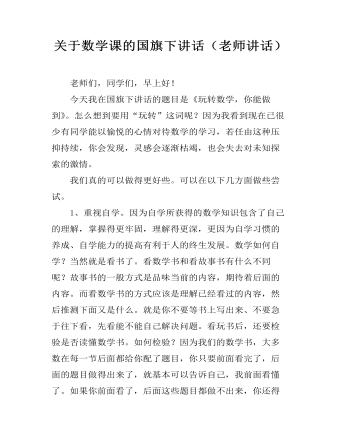
关于数学课的国旗下讲话(老师讲话)
老师们,同学们,早上好!今天我在国旗下讲话的题目是《玩转数学,你能做到》。怎么想到要用“玩转”这词呢?因为我看到现在已很少有同学能以愉悦的心情对待数学的学习,若任由这种压抑持续,你会发现,灵感会逐渐枯竭,也会失去对未知探索的激情。我们真的可以做得更好些。可以在以下几方面做些尝试。1、重视自学。因为自学所获得的数学知识包含了自己的理解,掌握得更牢固,理解得更深,更因为自学习惯的养成、自学能力的提高有利于人的终生发展。数学如何自学?当然就是看书了。看数学书和看故事书有什么不同呢?故事书的一般方式是品味当前的内容,期待着后面的内容。而看数学书的方式应该是理解已经看过的内容,然后推测下面又是什么。就是你不要等书上写出来、不要急于往下看,先看能不能自己解决问题。看玩书后,还要检验是否读懂数学书。如何检验?因为我们的数学书,大多数在每一节后面都给你配了题目,你只要前面看完了,后面的题目做得出来了,就基本可以告诉自己,我前面看懂了。如果你前面看了,后面这些题目都做不出来,你还得重新再去看过。不要说,“我看过了,但是后面题目我一道都做不出来。”那你前面就没有用心去看过,我提议你要想着读数学书,这个想着,就是一边看一边想着,要动脑筋的看。
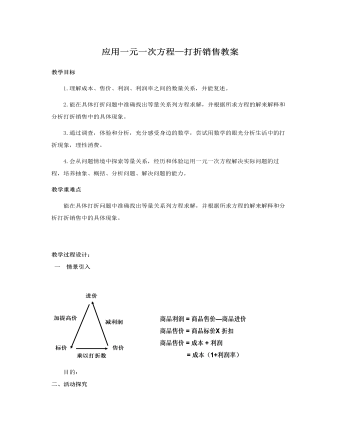
北师大初中七年级数学上册应用一元一次方程——打折销售教案2
两道例题,第一道题师生共同分析,第二道题学生自己分析。部分学生在运用方程解答问题时,等量关系的寻找还是有困难,规范解题不够合理,仍需在作业过程中教师给予适当的指导。四、课堂小结这节课我们学习了有关打折销售的知识,其实类似的问题我们小学也遇到过,今天在分析实际问题时又用到了列表法,通过这节课的学习,谈谈你在知识方面的收获。提示学生通过对《日历中的方程》《我变高了》以及本节《打折销售》学习还有以往经验,让学生分组讨论,用一元一次方程解决实际问题的一般步骤是什么?目的:让学生进一步体会方程的作用,这里教师又提到学生的小学学习,目的是想提示学生,将今天的方程解法与小学学过的算术方法相对比。此活动的目的是使学生不再处于被动状态,而成为积极的发现者。
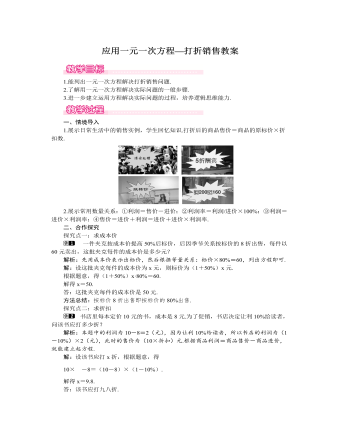
北师大初中七年级数学上册应用一元一次方程——打折销售教案1
方法总结:让利10%,即利润为原来的90%.探究点三:求原价某商场节日酬宾:全场8折.一种电器在这次酬宾活动中的利润率为10%,它的进价为2000元,那么它的原价为多少元?解析:本题中的利润为(2000×10%)元,销售价为(原价×80%)元,根据公式建立起方程即可.解:设原价为x元,根据题意,得80%x-2000=2000×10%.解得x=2750.答:它的原价为2750元.方法总结:典例关系:售价=进价+利润,售价=原价×打折数×0.1,售价=进价×(1+利润率).三、板书设计本节课从和我们的生活息息相关的利润问题入手,让学生在具体情境中感受到数学在生活实际中的应用,从而激发他们学习数学的兴趣.根据“实际售价=进价+利润”等数量关系列一元一次方程解决与打折销售有关的实际问题.审清题意,找出等量关系是解决问题的关键.另外,商品经济问题的题型很多,让学生触类旁通,达到举一反三,灵活的运用有关的公式解决实际问题,提高学生的数学能力.
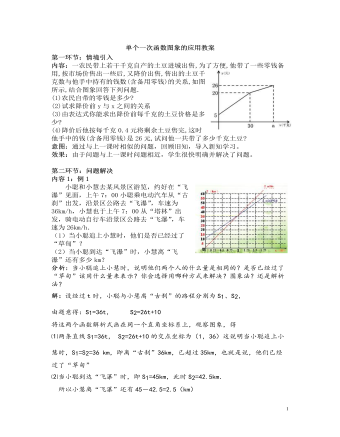
北师大初中数学八年级上册单个一次函数图象的应用2教案
(1)用简洁明快的语言概括大意,不能超过200字;(2)图表中能确定的数值,在故事叙述中不得少于3个,且要分别涉及时间、路和速度这三个量.意图:旨在检测学生的识图能力,可根据学生情况和上课情况适当调整。说明:练习注意了问题的梯度,由浅入深,一步步引导学生从不同的图象中获取信息,对同学的回答,教师给予点评,对回答问题暂时有困难的同学,教师应帮助他们树立信心。第四环节:课时小结内容:本节课我们学习了一次函数图象的应用,在运用一次函数解决实际问题时,可以直接从函数图象上获取信息解决问题,当然也可以设法得出各自对应的函数关系式,然后借助关系式完全通过计算解决问题。通过列出关系式解决问题时,一般首先判断关系式的特征,如两个变量之间是不是一次函数关系?当确定是一次函数关系时,可求出函数解析式,并运用一次函数的图象和性质进一步求得我们所需要的结果.
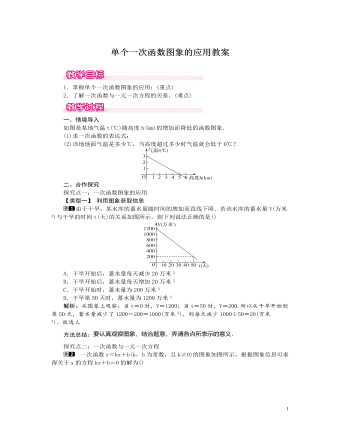
北师大初中数学八年级上册单个一次函数图象的应用1教案
方法总结:要认真观察图象,结合题意,弄清各点所表示的意义.探究点二:一次函数与一元一次方程一次函数y=kx+b(k,b为常数,且k≠0)的图象如图所示,根据图象信息可求得关于x的方程kx+b=0的解为()A.x=-1B.x=2C.x=0D.x=3解析:首先由函数经过点(0,1)可得b=1,再将点(2,3)代入y=kx+1,可求出k的值为1,从而可得出一次函数的表达式为y=x+1,再求出方程x+1=0的解为x=-1,故选A.方法总结:此题主要考查了一次函数与一元一次方程的关系,关键是正确利用待定系数法求出一次函数的关系式.三、板书设计一次函数的应用单个一次函数图象的应用一次函数与一元一次方程的关系探究的过程由浅入深,并利用了丰富的实际情景,增加了学生的学习兴趣.教学中要注意层层递进,逐步让学生掌握求一次函数与一元一次方程的关系.教学中还应注意尊重学生的个体差异,使每个学生都学有所获.
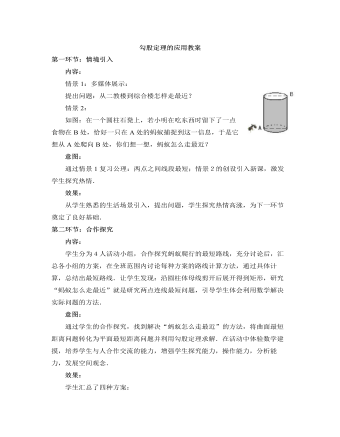
北师大初中数学八年级上册勾股定理的应用2教案
内容:情景1:多媒体展示:提出问题:从二教楼到综合楼怎样走最近?情景2:如图:在一个圆柱石凳上,若小明在吃东西时留下了一点食物在B处,恰好一只在A处的蚂蚁捕捉到这一信息,于是它想从A处爬向B处,你们想一想,蚂蚁怎么走最近?意图:通过情景1复习公理:两点之间线段最短;情景2的创设引入新课,激发学生探究热情.效果:从学生熟悉的生活场景引入,提出问题,学生探究热情高涨,为下一环节奠定了良好基础.第二环节:合作探究内容:学生分为4人活动小组,合作探究蚂蚁爬行的最短路线,充分讨论后,汇总各小组的方案,在全班范围内讨论每种方案的路线计算方法,通过具体计算,总结出最短路线.让学生发现:沿圆柱体母线剪开后展开得到矩形,研究“蚂蚁怎么走最近”就是研究两点连线最短问题,引导学生体会利用数学解决实际问题的方法.
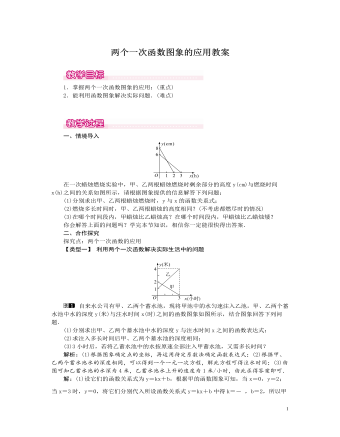
北师大初中数学八年级上册两个一次函数图象的应用1教案
解:∵y=23x+a与y=-12x+b的图象都过点A(-4,0),∴32×(-4)+a=0,-12×(-4)+b=0.∴a=6,b=-2.∴两个一次函数分别是y=32x+6和y=-12x-2.y=32x+6与y轴交于点B,则y=32×0+6=6,∴B(0,6);y=-12x-2与y轴交于点C,则y=-2,∴C(0,-2).如图所示,S△ABC=12BC·AO=12×4×(6+2)=16.方法总结:解此类题要先求得顶点的坐标,即两个一次函数的交点和它们分别与x轴、y轴交点的坐标.三、板书设计两个一次函数的应用实际生活中的问题几何问题进一步训练学生的识图能力,能通过函数图象获取信息,解决简单的实际问题,在函数图象信息获取过程中,进一步培养学生的数形结合意识,发展形象思维.在解决实际问题的过程中,进一步发展学生的分析问题、解决问题的能力和数学应用意识.
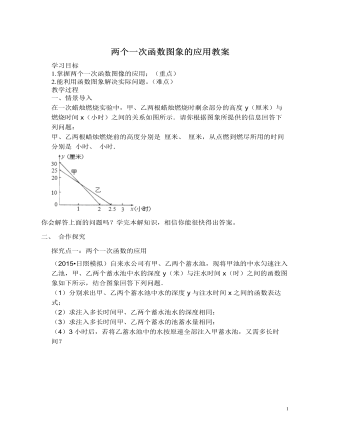
北师大初中数学八年级上册两个一次函数图象的应用2教案
学习目标1.掌握两个一次函数图像的应用;(重点)2.能利用函数图象解决实际问题。(难点)教学过程一、情景导入在一次蜡烛燃烧实验中,甲、乙两根蜡烛燃烧时剩余部分的高度y(厘米)与燃烧时间x(小时)之间的关系如图所示.请你根据图象所提供的信息回答下列问题:甲、乙两根蜡烛燃烧前的高度分别是 厘米、 厘米,从点燃到燃尽所用的时间分别是 小时、 小时.你会解答上面的问题吗?学完本解知识,相信你能很快得出答案。二、 合作探究探究点一:两个一次函数的应用(2015?日照模拟)自来水公司有甲、乙两个蓄水池,现将甲池的中水匀速注入乙池,甲、乙两个蓄水池中水的深度y(米)与注水时间x(时)之间的函数图象如下所示,结合图象回答下列问题.(1)分别求出甲、乙两个蓄水池中水的深度y与注水时间x之间的函数表达式;(2)求注入多长时间甲、乙两个蓄水池水的深度相同;(3)求注入多长时间甲、乙两个蓄水的池蓄水量相同;
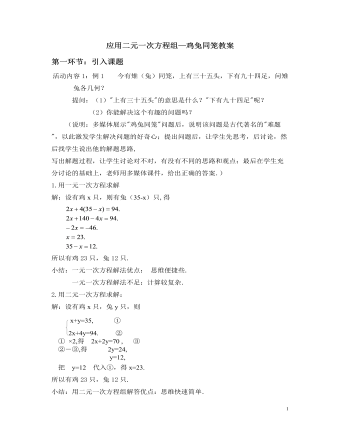
北师大初中数学八年级上册应用二元一次方程组——鸡兔同笼2教案
第三环节:课堂小结活动内容:1. 通过前面几个题,你对列方程组解决实际问题的方法和步骤掌握的怎样?2. 这里面应该注意的是什么?关键是什么?3. 通过今天的学习,你能不能解决求两个量的问题?(可以用二元一次方程组解决的。4. 列二元一次方程组解决实际问题的主要步骤是什么?说明:通过以上四个问题,学生基本上掌握了列二元一次方程组解决实际问题的方法和步骤,可启发学生说出自己的心得体会及疑问.活动意图:引导学生自己小结本节课的知识要点及数学方法,使知识系统化.说明:还可以建议有条件的学生去读一读《孙子算经》,可以在网上查,找出自己喜欢的问题,互相出题;同位的同学还可互相编题考察对方;还可以设置"我为老师出难题"活动,每人编一道题,给老师,老师再提出:"谁来帮我解难题",以此激发学生的学习兴趣和信心。

北师大初中数学八年级上册应用二元一次方程组——鸡兔同笼1教案
解:设甲班的人数为x人,乙班的人数为y人,根据题意,得x+y=93,14x+13y=27,解得x=48,y=45.答:甲班的人数为48人,乙班的人数为45人.方法总结:设未知数时,一般是求什么,设什么,并且所列方程的个数与未知数的个数相等.解这类问题的应用题,要抓住题中反映数量关系的关键字:和、差、倍、几分之几、比、大、小、多、少、增加、减少等,明确各种反映数量关系的关键字的含义.三、板书设计列方程组,解决问题)一般步骤:审、设、列、解、验、答关键:找等量关系通过“鸡兔同笼”,把同学们带入古代的数学问题情景,学生体会到数学中的“趣”;进一步强调数学与生活的联系,突出显示数学教学的实际价值,培养学生的人文精神;进一步丰富学生数学学习的成功体验,激发学生对数学学习的好奇心,进一步形成积极参与数学活动、主动与他人合作交流的意识.
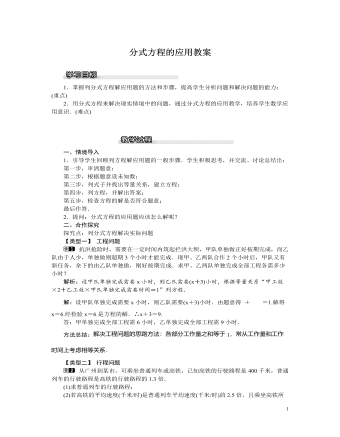
北师大初中八年级数学下册分式方程的应用教案
解:(1)设第一次购买的单价为x元,则第二次的单价为1.1x元,根据题意得14521.1x-1200x=20,解得x=6.经检验,x=6是原方程的解.(2)第一次购买水果1200÷6=200(千克).第二次购买水果200+20=220(千克).第一次赚钱为200×(8-6)=400(元),第二次赚钱为100×(9-6.6)+120×(9×0.5-6.6)=-12(元).所以两次共赚钱400-12=388(元).答:第一次水果的进价为每千克6元;该老板两次卖水果总体上是赚钱了,共赚了388元.方法总结:本题具有一定的综合性,应该把问题分解成购买水果和卖水果两部分分别考虑,掌握这次活动的流程.三、板书设计列分式方程解应用题的一般步骤是:第一步,审清题意;第二步,根据题意设未知数;第三步,根据题目中的数量关系列出式子,并找准等量关系,列出方程;第四步,解方程,并验根,还要看方程的解是否符合题意;最后作答.
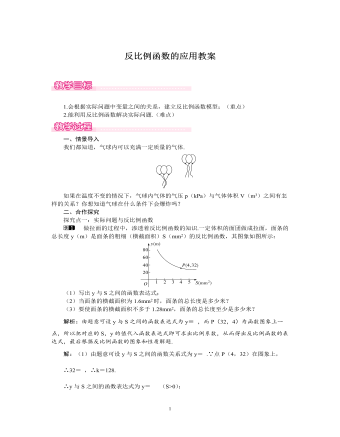
北师大初中数学九年级上册反比例函数的应用1教案
因为反比例函数的图象经过点A(1.5,400),所以有k=600.所以反比例函数的关系式为p=600S(S>0);(2)当S=0.2时,p=6000.2=3000,即压强是3000Pa;(3)由题意知600S≤6000,所以S≥0.1,即木板面积至少要有0.1m2.方法总结:本题渗透了物理学中压强、压力与受力面积之间的关系p= ,当压力F一定时,p与S成反比例.另外,利用反比例函数的知识解决实际问题时,要善于发现实际问题中变量之间的关系,从而进一步建立反比例函数模型.三、板书设计反比例函数的应用实际问题与反比例函数反比例函数与其他学科知识的综合经历分析实际问题中变量之间的关系,建立反比例函数模型,进而解决问题的过程,提高运用代数方法解决问题的能力,体会数学与现实生活的紧密联系,增强应用意识.通过反比例函数在其他学科中的运用,体验学科整合思想.
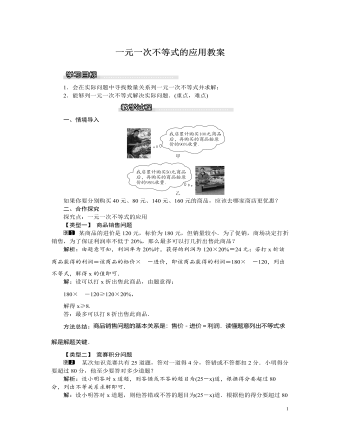
北师大初中八年级数学下册一元一次不等式的应用教案
有三种购买方案:购A型0台,B型10台;A型1台,B型9台;A型2台,B型8台;(2)240x+200(10-x)≥2040,解得x≥1,∴x为1或2.当x=1时,购买资金为12×1+10×9=102(万元);当x=2时,购买资金为12×2+10×8=104(万元).答:为了节约资金,应选购A型1台,B型9台.方法总结:此题将现实生活中的事件与数学思想联系起来,属于最优化问题,在确定最优方案时,应把几种情况进行比较.三、板书设计应用一元一次不等式解决实际问题的步骤:实际问题――→找出不等关系设未知数列不等式―→解不等式―→结合实际问题确定答案本节课通过实例引入,激发学生的学习兴趣,让学生积极参与,讲练结合,引导学生找不等关系列不等式.在教学过程中,可通过类比列一元一次方程解决实际问题的方法来学习,让学生认识到列方程与列不等式的区别与联系.
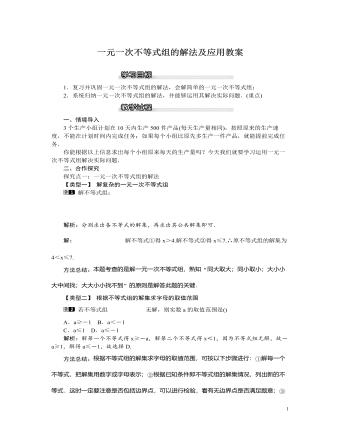
北师大初中八年级数学下册一元一次不等式组的解法及应用教案
安装及运输费用为600x+800(12-x),根据题意得4000x+3000(12-x)≤40000,600x+800(12-x)≤9200.解得2≤x≤4,由于x取整数,所以x=2,3,4.答:有三种方案:①购买甲种设备2台,乙种设备10台;②购买甲种设备3台,乙种设备9台;③购买甲种设备4台,乙种设备8台.方法总结:列不等式组解应用题时,一般只设一个未知数,找出两个或两个以上的不等关系,相应地列出两个或两个以上的不等式组成不等式组求解.在实际问题中,大部分情况下应求整数解.三、板书设计1.一元一次不等式组的解法2.一元一次不等式组的实际应用利用一元一次不等式组解应用题关键是找出所有可能表达题意的不等关系,再根据各个不等关系列成相应的不等式,组成不等式组.在教学时要让学生养成检验的习惯,感受运用数学知识解决问题的过程,提高实际操作能力.
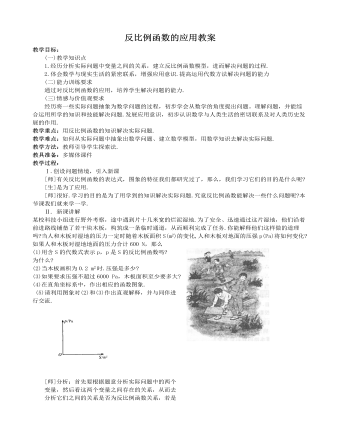
北师大初中数学九年级上册反比例函数的应用2教案
补充题:为了预防“非典”,某学校对教室采用药熏消毒,已知药物燃烧时,室内每立方米空气中的含药量y(毫克)与时间x(分钟)成为正比例,药物燃烧后,y与x成反比例(如右图),现测得药物8分钟燃毕,此时室内空气中每立方米的含药量6毫克,请根据题中所提供的信息,解答下列问题:(1)药物燃烧时,y关于x的函数关系式为 ,自变量x的取值范围为 ;药物燃烧后,y关于x的函数关系式为 .(2)研究表明,当空气中每立方米的含药量低于1.6毫克时学生方可进教室,那么从消毒开始,至少需要经过______分钟后,学生才能回到教室;(3)研究表明,当空气中每立方米的含药量不低于3毫克且持续时间不低于10分钟时,才能有效杀灭空气中的病菌,那么此次消毒是否有效?为什么?答案:(1)y= x, 010,即空气中的含药量不低于3毫克/m3的持续时间为12分钟,大于10分钟的有效消毒时间.

